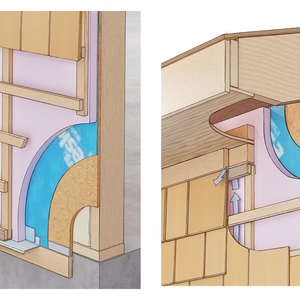Discussion Forum
Discussion Forum
Up Next
Video Shorts
Featured Story

Getting the details right for a wall assembly with the control layers to the exterior and lots of drying potential.
Featured Video
Builder’s Advocate: An Interview With ViewrailHighlights
"I have learned so much thanks to the searchable articles on the FHB website. I can confidently say that I expect to be a life-long subscriber." - M.K.
Fine Homebuilding Magazine
- Home Group
- Antique Trader
- Arts & Crafts Homes
- Bank Note Reporter
- Cabin Life
- Cuisine at Home
- Fine Gardening
- Fine Woodworking
- Green Building Advisor
- Garden Gate
- Horticulture
- Keep Craft Alive
- Log Home Living
- Military Trader/Vehicles
- Numismatic News
- Numismaster
- Old Cars Weekly
- Old House Journal
- Period Homes
- Popular Woodworking
- Script
- ShopNotes
- Sports Collectors Digest
- Threads
- Timber Home Living
- Traditional Building
- Woodsmith
- World Coin News
- Writer's Digest


















Replies
not a bad idea for setting trusses. Especially without a crane. Get it within 5" and just cinch it in. I don't think there is much use for setting studs though. I don't see why you couldn't use it for joists and rafter too though. $40 sounds like a bargain if it's well constructed.
If it works as spoken it'll be a winner.
Yet history is full of good ideas that went no where.
What i'd like to se invented is a tool like a bolt cutter but with the cutting head turned so it could clip the heads off nails in a valley.
It could be used on almost any nail but it would be esp. useful in demo work when you are trying to save corregated tin. You could just cut the head off the nail and remove the tin w/o prying on it.
If anyone invents it I hope you make a million $$. I just want to buy one.
Like end nippers?http://www.channellock.com/acb/stores/1/35-300_-_12_inch_Concretors_N_P94C14.cfm
lankford,Get a hoof trimmer.http://www.hoof-trimmers.com/osCommerce/index.php?cPath=8&osCsid=e7a1d60b9dc9b68ff7deb97040a2ca0fKK
Maybe something like this
View Image
Jon Blakemore RappahannockINC.com Fredericksburg, VA
That's kinda close to waht I am thinking about but the cutter ends are too wide to get into real close quarters.
think of something like if you put you're fingers together to pinch the head off a nail if it was down on a "v" groove.
Probably take something made out of carbide to stay sharp enough and would need compound leverage.
The jaws being too wide is what keeps end nippers and hoof trimmers from working.
Maybe something like this?View Image
Jon Blakemore RappahannockINC.com Fredericksburg, VA
I would not be interested in that tool.
Rookies and amatuers might not understand that it's not the cat's meow and they might buy it. I wish the guy all the success he seeks but I wouldn't use it if he gave it to me for free.
I've tried and rejected many, many, many systems and techniques for setting trusses. The primary problem with his tool is that it will only lock in one truss to the previously anchored truss. We always sent two trusses and our system easily handled them.
That contraption appears to be a two handed tool. That's not good. The tool also would be hard to line up because of the relatively deep throat of the clamps. The two trusses being tied would have to be very close to perfectly parallel. That is sometimes very hard to do when you are wrestling a 1500# truss that is blowing in the wind.
There are several things that I would change on his design, IF I was going to manufacture or use it but to me, it's useless. I wouldn't accept one free.
""That is sometimes very hard to do when you are wrestling a 1500# truss that is blowing in the wind. "' 1500# truss?
Typo ? I haven't seen too many of those in residential work. 150# is closer to the weight.
They can't get your Goat if you don't tell them where it is hidden.
1500# truss? Typo ?
I haven't seen too many of those in residential work. 150# is closer to the weight.
I've seen plenty.
One fine point..."That contraption appears to be a two handed tool. "
That was my first impression, but I think the lower part is actually a reflection in the photo trying to be artsy... bad move IMHO.PaulB
http://www.makeabettertomorrow.com
http://www.finecontracting.com
I wasn't fooled by the reflection. The contraption would take both hands to use and set and that wouldn't be a deal breaker for most crews. Conceptually, the contraption makes sense. In practice, it makes a lot of sense if you only send one truss at a time. Many crews only send one at a time so this would be a good tool for them.
Many crews only send one at a time so this would be a good tool for them.>>>>>>>>>>>>>>>>>>>>>>
And then they wonder why it is so hard to make money!
1500# truss is pretty heavy. I have set a few, but few and far between. Did I mention I hate dealing with them?>G<
Did I forget that we tried to always send 3 at a time. I agree it would be useless in that case!
Edited 8/26/2009 3:08 pm ET by frammer52
The big 1500# trusses are either multiply girders or gables already sheathed and sided. We had our share of them.
I tried several systems for sending three trusses up but never found any advantage over sending two trusses. The way we did it, sending two, resulted in the crane never stopping and the truss setters never were waiting. Any time I tried different systems, either the crane would be waiting or the guys would be waiting.
We sent 3 with a man stationed in the middle who unhocked and held the trusses until the men on the ends set the ends with one or 2 guys nailing blocks.
Very efficient but you had to have a decent size crew.
I knew you were talking about girders etc. when you talked about 1500#'s.
Ever set 90'ers?
I don't know that I set anything as long as 90'. I do remember a commercial building with 40' piggys. My quick mental math tells me that if they can send 40' piggys, the bottom must have been 80'.
I'm thinking that I rode the top alone on those but it doesn't sound logical. I do remember having a system of using 16' plate stock for the top lacers. I didn't want to have a bunch of small blocks up there that weren't going to function as permanent lacers, so I concocted a system of setting 16' linear up there and dragged and set it as we went. It worked great.
I did use some home made "truss setters" for those trusses. They were a huge help and there was some very specific things I did to those tools specifically because I was going to be up there dangling in the breeze and dragging all that linear around.
I made jobsite built truss setters for many different occcasions. I only rarely carried them from job to job. There were several different "needs" that were incorporated into their production and I see none of them on the tool that this guy is selling. That's the main reason that I KNOW I wouldn't want his tool.
"'The big 1500# trusses are either multiply girders or gables already sheathed and sided."" Probably 90% of residential trusses weigh in at less than 250#'s and the majority of those at probably close to 150# or less.
I read the write up to indicate havign one truss set in place and then using it run out the following trusses. I don't know that I would have used on a daily basis but can say that I can see that at times it would have been just the tool for the job. As for the two hands.. ""No more need for a tape measure while your trying to balance yourself on the top of a 4" wide wall while setting a 30' wide truss, just get it close and lock it down in a matter of seconds and only using one hand.""
They can't get your Goat if you don't tell them where it is hidden.
As for the two hands..
""No more need for a tape measure while your trying to balance yourself on the top of a 4" wide wall while setting a 30' wide truss, just get it close and lock it down in a matter of seconds and only using one hand.""
Maybe therein lies the problem. If he based his entire invention on the premise that someone was holding a tape measure as a tool for setting trusses, then he has sadly missed the mark. I don't know anyone that needed a tape measure out while the trusses were being flown in.
The tool is obviously designed to set one truss. While I have no issue with setting only one truss (we often set only one truss in specific sections), I do have an opinion that if we are only setting one truss, I don't really need any special tool to help me. I'm going to need a lacer and some nails or the nailgun. Before the truss arrives, I will have them poised, or nailed, awaiting the truss. I will hold the truss with my hand, while I deliver the nail that locks it in. I will not be "balancing on a 4" wall" because if I was, the lacer would be so far from the top that the truss wouldn't be properly laced.
So, his language tells me that he is aiming his adverts at guys that don't do this everyday.
I think the problem with that tool is that it will multiply mistakes. If that tool does not set the trusses or joists or whatever dead on, say 1/16th off, then eventually you will be off by a large amount.
Maybe that really won't be a problem but it comes to mind.
Also, it simply looks to cumbersome to be dragging around. I think I am so used to other methods I couldn't get used to using this device.
I refuse to accept that there are limitations to what we can accomplish. Pete Draganic
Take life as a test and shoot for a better score each day. Matt Garcia
Hey!
Brick Tongs for carpenters!
Wonders never cease.
Despite the negative majority, I think it may be worth the money. I've used cases of the Mitek truss bracer and they worked well but you need a case per house and they are not giving them away. I set one truss at a time and don't like dragging air hoses etc on a ladder or the top plate of a wall. It looks like it it would work well.
Have a good day
Cliffy